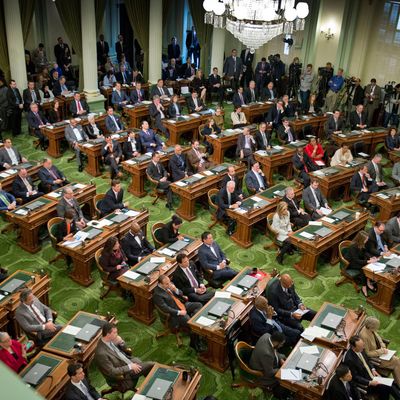
A statistic you see a lot in Democrats-in-disarray stories is of the large and growing advantage Republicans have in the total number of state legislators each party can claim. Here’s an example from the Hill right after the 2016 elections:
The Democratic Party will hit a new nadir in state legislative seats after suffering more losses in November’s elections, highlighting the devastation up and down the party across the nation.
Republicans will control 4,170 state legislative seats after last week’s elections, while Democrats will control 3,129 seats in the nation’s 98 partisan legislative chambers. Republicans picked up a net gain of 46 seats in Tuesday’s elections, while Democrats lost 46 seats, according to the latest vote counts from The Associated Press.
No data point is entirely insignificant. But the relevance of bean-counting state legislators across all 50 states is limited once you realize the size of legislatures bears no predictable association to the population served. The wild variations are being illustrated especially well by a lawsuit from rural voters in California attacking that state’s vast state legislative districts as preventing any sort of effective representation.
The suit takes aim at California’s limit on representatives in the legislature — set in 1862 — and alleges that the increase in the state’s population without increases in representatives has led to violations of Constitutional rights and to a variety of maladies.
The complaint notes that in 1862, the state capped the number of senators at 40, and the number of Assembly members at 80, when the population was less than 420,000.
An exhibit attached to the complaint shows that in 1862, that meant there were 5,201 constituents per Assembly member, and 10,401 constituents per senator.
With the state’s population estimated to be 39,200,000 in 2016, the ratio changed to 490,000 constituents per Assembly member and 980,000 per senator, according to the attachment.
That means California’s state senators represent more people than all but one member of the U.S. House of Representatives (Montana’s famous journalist-beater Greg Gianforte, who represents 994,000 people).
Unsurprisingly, California’s huge districts make for some of the more expensive state legislative races in the country. But according to the plaintiffs in the suit against the state, it also means widely scattered voters in the part of California north of the Bay Area are less likely to have legislators focused on their particular interests.
It is unclear how viable the lawsuit is; the 120-member legislature is enshrined in the California constitution, which is probably why the plaintiffs allege their federal constitutional rights are being violated. But the suit will help draw needed attention to how wildly the states vary in the ratio of legislators to people. At the other end of the spectrum from California’s 980,000 people for each senator is New Hampshire’s 3,300 people for each member of that state’s lower house. You can argue all day about which state’s legislature does a better job of representing its constituents. But it should be obvious that a partisan swing of 100 or so House seats in New Hampshire doesn’t take remotely as many changed minds as a swing of one California senate seat.
That should be kept in mind next time you hear that that a net gain or loss of 46 random state legislators from across the country epitomizes one party’s strength and another’s weakness.






























